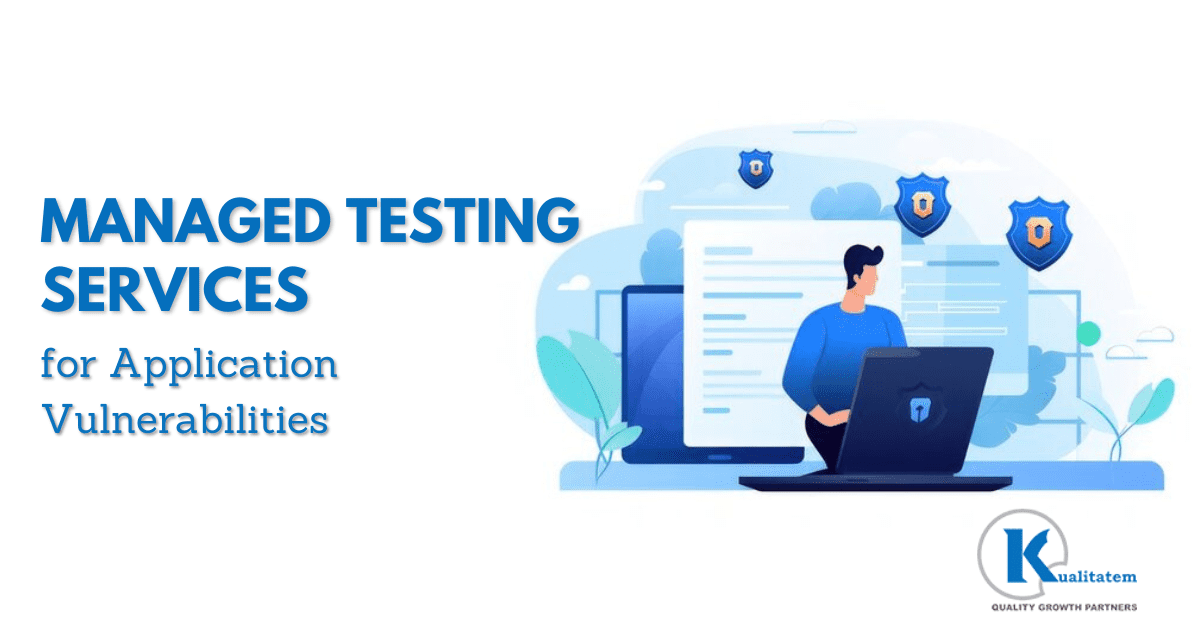Securing Apps: Managed Testing Services for Application Vulnerabilities

- August 29, 2023
- admin
In today’s swiftly transforming digital sphere, ensuring robust application security has become a paramount concern for global organizations. As the intricacy of cyber threats escalates, conventional security measures find themselves outpaced, often failing to adequately shield sensitive data and uphold the sanctity of critical applications. To counter this, Managed Testing Services (MTS) have emerged as a potent solution, meticulously identifying and preemptively resolving application vulnerabilities.
This expansive article delves into MTS’s pivotal role in surmounting security challenges. It probes its methodologies, delves into its manifold benefits, and expounds on how it effectively empowers organizations to fortify their application defenses.
Understanding the Landscape of Application Vulnerabilities
The Prevalence of Application Vulnerabilities:
The digital landscape is rife with application vulnerabilities. A comprehensive exploration of this territory involves thoroughly examining common vulnerabilities such as SQL injections, cross-site scripting (XSS), and their ilk. This is further enriched by scrutinizing the palpable real-world consequences stemming from these vulnerabilities. However, this is only a facet of the broader tapestry. In the ever-evolving threat panorama, Advanced Persistent Threats (APTs) and zero-day exploits have emerged as potent instruments of cyber offense. Equally intriguing are social engineering tactics and the sinister realm of supply chain attacks, further compounding the complexity of this domain.
The Implications of Application Vulnerabilities:
The repercussions of application vulnerabilities ripple across multiple dimensions. A meticulous dissection reveals that data breaches are not merely a monetary drain; they take a substantial toll on organizations. The financial losses incurred due to such breaches are staggering, compelling the adoption of robust security measures. However, the impact extends beyond the economic realm. Brand reputation is fragile, susceptible to the scars inflicted by security incidents. Establishing trust with customers becomes a monumental endeavor, and fostering a culture of faith becomes paramount.
The Role of Managed Testing Services in Application Security
Defining Managed Testing Services (MTS):
The multifaceted embrace of Managed Testing Services (MTS) is at the core of modern application security architecture. This encompasses a rich repertoire of security assessments—penetration testing, vulnerability scanning, and code reviews—that engender a comprehensive approach. In the spirit of adaptability, MTS can be elegantly tailored to accommodate the demands of diverse industry verticals, entwining seamlessly with the intricate threads of compliance standards. Beyond the technical marvel, MTS is a beacon of compliance, manifesting adherence to industry benchmarks and steadfast commitment to stakeholders and patrons alike.
Advantages of Managed Testing Services for Application Security:
The advantages conferred by MTS on application security are manifold. It unfurls as a proactive sentinel, diligently scanning the horizon for vulnerabilities yet to materialize into threats. By enabling organizations to pre-emptively address emerging perils, MTS truncates the exposure window, making it a formidable adversary for cyber attackers. The proficiency of skilled, ethical hackers and security analysts is pivotal in this narrative. Their nuanced understanding transcends the capabilities of automated tools, allowing them to unearth vulnerabilities that might otherwise evade detection.
Furthermore, MTS exists in collaboration. Its integration into the Software Development Lifecycle (SDLC) is a strategic maneuver that ensures security is a core facet of the developmental journey. The secure coding practices and continuous monitoring that emanate from this integration bolster the bastion of security.
Methodologies of Managed Testing Services
Penetration Testing: Identifying Real-World Weaknesses:
The domain of penetration testing unfolds as an intricate dance of controlled exploration. The methodology begins with meticulous planning and scoping, underscoring the importance of delineating objectives and rules of engagement. Critical assets are judiciously selected for targeted evaluation, setting the stage for the subsequent symphony. This act is none other than the controlled execution of hacking engagements, where real-world attacks are simulated to assess the application’s mettle. In this arena, potential attack vectors are exposed, and points of vulnerability are laid bare. The closing act of this drama involves crafting comprehensive reports replete with actionable insights, which are then presented to stakeholders for further orchestration.
Vulnerability Scanning: Scalable Security Assessments:
Embracing automation, vulnerability scanning emerges as a potent instrument in the MTS toolkit. This automated approach is ideal for large-scale assessments that scan environments for known vulnerabilities and configuration quirks. Yet the true power of vulnerability scanning unfurls when it converges with the art of penetration testing. The unison of these methodologies amplifies their efficacy, extending a panoramic coverage of security assessments. However, vulnerability scanning has limitations, notably in comparison to ethical hacking. These boundaries are recognized and addressed through vigilant monitoring and proactive remediation, exemplifying a holistic approach to security.
Code Reviews: Unveiling Application Security Insights:
The fabric of application security is intricately woven through the art of code review. Here, the intricacies of source code are laid bare to the discerning eyes of security experts. The significance of secure coding practices looms large as they weave the armor that shields applications from vulnerabilities. This process entails meticulously identifying common coding errors and latent security gaps. Collaboration is a cornerstone, bridging the chasm between security experts and developers. This synergy facilitates the identification of risks and the formulation of tailored remediation strategies.
The Path to a More Secure Future
In the kinetic expanse of the cyber landscape, organizations stand as sentinels of security. Managed Testing Services provide an arsenal of strategies to identify and quell application vulnerabilities. Organizations erect an impregnable fortress of defense by seamlessly weaving MTS into their security fabric. This aegis envelops sensitive data, safeguards reputation, and rallies resilience against the ever-shifting backdrop of security challenges. With MTS as their guide, organizations forge ahead, eyes fixed on the horizon and equipped to preclude, detect, and respond to emerging threats. As true defenders of the digital realm, they stride forth, cybersecurity champions, ready to script the saga of secure application architecture.











